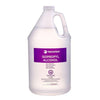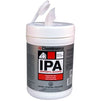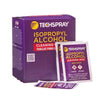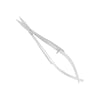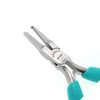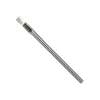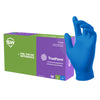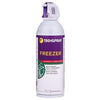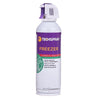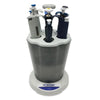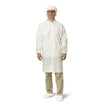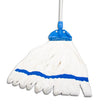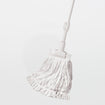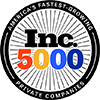- No products in the cart.
Essential Laboratory Supplies and Equipment Needed to Set Up Your Class 10,000 (ISO 7) Cleanroom
Dec
17
2020
What is a Class 10,000 (ISO 7) Cleanroom?
A class 10,000 cleanroom, or ISO 7, is the most common type of cleanroom. This type of cleanroom permits only 10,000 particles of size 0.5 µm or larger per cubic ft. of air in the room. Manufacturing industries that might need class 10,0000 cleanrooms include aerospace, assembly of touchscreen membranes, injection molded parts, SMT assembly, solar, e-liquid, food packaging, nutraceutical packaging, pharmaceutical compounding, device reprocessing, and medical device packaging. Ensure that you have the lab supplies and equipment to set up your Class 10,0000 cleanroom by visiting Lab Pro’s Cleanroom Manufacturing page.

ISO 7 Cleanroom Classifications
The naming for ISO classroom identifications (ISO standard 146144-1:2015) are based on the decimal logarithm of the number of permissible particles ≥ 0.1 µm or larger per m3 of air, while the numbered classes of Federal Standard 209E indicate the number of permissible particles ≥ 0.5 mm/ft3 of air.
For Class 10,000 cleanrooms, particles smaller than 0.5 microns are not considered. The concentration of particles of ≥0.5 µm should be below 352,000/m3 (10,000 particles per ft3). The concentration of particles of 1 micron and above should be 83,200/m3 or lower. Particles 5 microns and above should be 2,930/m3 or lower.
Airborne Particulate Cleanliness for Class 10,000 Cleanroom
|
Micron |
0.1 |
0.2 |
0.3 |
0.5 |
1 |
5 |
|
Particles/m3 |
352,000 |
83,200 |
2,930 |
Schedule of Tests to Demonstrate Continuing Compliance for Class 10,000 Cleanroom
|
Test Parameter |
Class |
Maximum Time Interval |
Test Procedure |
|
Particle Count Test |
> ISO 5 |
12 Months |
ISO 14644-1 Annex A |
|
Air Pressure Difference |
All Classes |
12 Months |
ISO 14644-1 Annex B5 |
|
Airflow |
All Classes |
12 Months |
ISO 14644-1 Annex B4 |
It is best practice to have an ISO 8 airlock or gowning room preceding the ISO 7 room. A class 10,000 cleanroom typically uses non-unidirectional airflow, or a turbulent airflow system, to maintain a clean, particulate-free environment.
Federal and ISO Airflow Velocity Recommendations for Class 10,000 Cleanroom
|
Class: ISO 146144-1 (Federal Standard 209E) |
Average Airflow Velocity (m/s (ft/min)) |
Air Changes Per Hour |
Ceiling Coverage |
|
ISO 7 (Class 10,000) |
0.051 – 0.076 (10 -15) |
60-90 |
15-20% |
Garments
To minimize contamination of particulates in your Class 10,000 cleanroom, use non-shedding garments to protect the environment. The American "Institute of Environmental Sciences and Technology" (IEST) recommends the following clothing for Class 10,000 (ISO7) cleanrooms.
Non-aseptic cleanroom application
- Hood, Cap or Hair Cover
- Coverall or Frock
- Boots or Footwear
- Facial Cover (Optional)
- Gloves (Optional)
Frequency of Change: 2 Times/Week
Aseptic cleanroom application
- Hood
- Hair Cover
- Coverall
- Boots
- Facial Cover
- Gloves
Frequency of Change: Per Entry
Source: IEST - Garment System Considerations for Cleanrooms and Other Controlled Environments.
Lab Pro stocks a wide variety of sizes and styles of garments suitable for your Class 10,000 cleanroom.
Coverall
- Dacron cleanroom coverall
- Advantage Pro polypropylene cleanroom coverall
- Coverall with hood and boot
- Microporous coverall
- Tians High Performance Static Dissipative Frock
- Tians high performance lab coats
- Tians high performance coverall with hood & zipper
Bouffant
- Low-linting polypropylene bouffant caps
Beard Cover
- Latex-free beard covers
Face Mask
- 3ply disposable non-woven fiber fabric face masks
Gloves (vinyl, latex, nitrile)
Shoe Cover
- LabClean Shoe Covers are made of 100% spun bond polypropylene and are non-skid
- Sterile boot covers
Gowning Area
Set up the gowning area for easy access to cleanroom garments.
- Tacky mats are needed at the entrance of a gowning room to remove particulates from before entering.
- Have shoe covers available to don after stepping on the tacky mats and before entering the gowning room.
- Setup up a garment supply area with frocks and gowns on one side and a separate shelf for hoods, masks, and other supplies. Metro garment racks are made of industry compliant stainless steel and are built for cleanliness and stability. Some storage cabinets are equipped with HEPA filtration to whisk away unwanted particles.
- Use an easy-to-clean gowning bench to don coverall. Have sterile wipes available for cleaning the bench after each use.
- Demarcate the clean/dirty floor with cleanroom tape. 5S systems can help improve efficiencies in cleanrooms.
- Only laundered booties are allowed in designated clean area (which is frequently cleaned with a fresh, nonwoven mop).
In the Cleanroom - Office Supplies
Everyday items such as pen, notepads, and paper are not designed for cleanroom settings. Lap Pro stocks the sundries you need for cleanroom recordkeeping.
- Cleanroom notebooks
- Cleanroom paper and sticky notes
- Cleanroom pen (this says microscope parts and accessories??)
In the Cleanroom - Tools and Equipment
Lab Pro sells equipment, tools, carts, and racks that are especially designed for use in cleanrooms. For an aseptic process, it is important that materials won’t shed, scratch or outgas, and that surfaces can easily be sterilized.
- Sterile pipettes
- Yamato cleanroom ovens
- Tools like tweezers, forceps, pliers, brushes, and hemostats
- Cleanroom swabs
- Cleanroom vacuum systems
- Cleanroom razor blade
- Metro microban dunnage racks and utility carts are rust and mildew
- Meters and monitors
- Racks, shelving, boxes, and bins
- Thermal holding and transport
- Trashcans and liners
Cleanroom Chemicals
Cleaning
Even though an ISO 7 cleanroom has less stringent cleanliness requirements than other classes, keeping surfaces wiped and particle free may be more challenging. Aseptic processes may require frequent disinfecting and sterilization.
- Cleanroom wipes
- Chemitronics Coventry cleanroom chamoix for removing solder flux
- Disinfectants
- Cleaners and degreasers
- Yamato sterilizers
- Screen cleaners for wiping screens, removing rosin-based fluxes or solder pastes
Cleanroom Testing
- Chemtronics foam or flocked sampling swabs
ISO 7
In class 10,000 cleanrooms, technicians wear fewer protective clothing than lower class cleanrooms, but many garments are still needed to cover street wear. Depending on industry, application, hazard, and sterility requirements, more types of PPE may be needed. Whether you are compounding pharmaceuticals or packaging medical devices, Lab Pro has the tools you need to set up your ISO 7 cleanroom space.
Note: These products and chemicals are meant to be used for research, industrial work, cleaning or disinfecting and should always be stored out of the reach of young children or infants.
For over 40 years, Lab Pro Inc. has been committed to delivering the highest quality chemicals, ESD protection, laboratory and cleanroom supplies to medical device and electronic manufacturing laboratories worldwide. To learn more, visit the biggest Lab Supply showroom in California, or contact us online or at 888-452-2776.
USA source for ISO documents - http://www.iest.org







